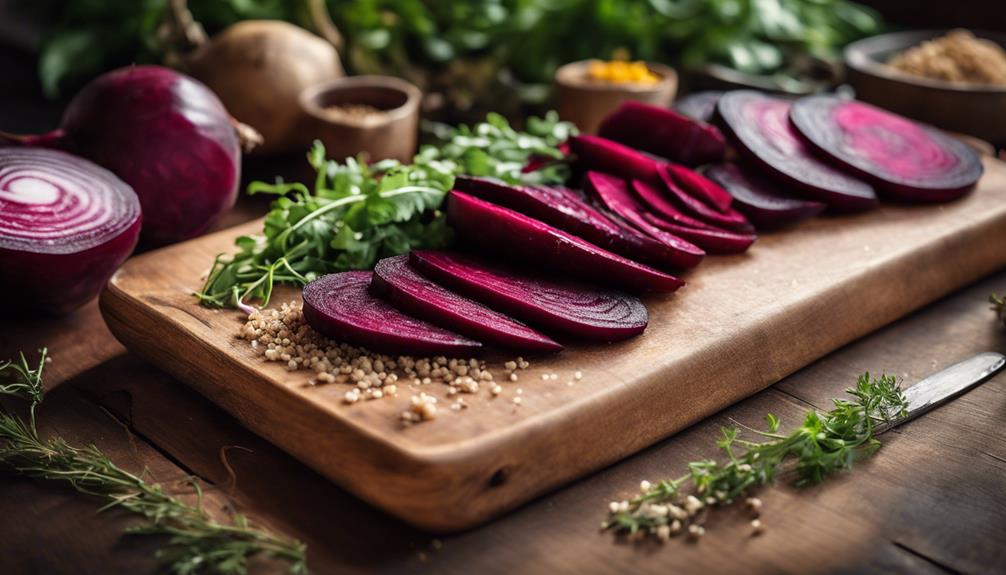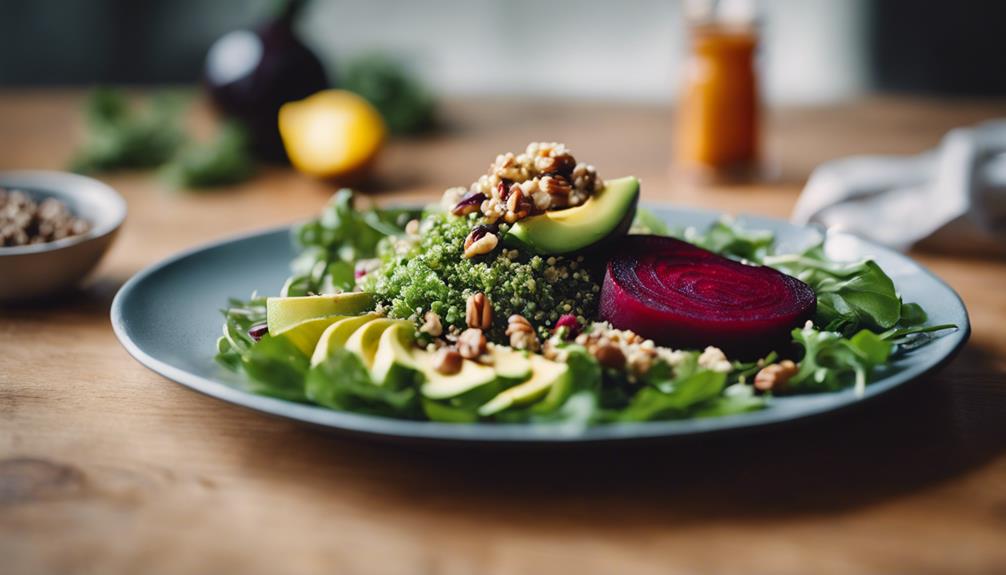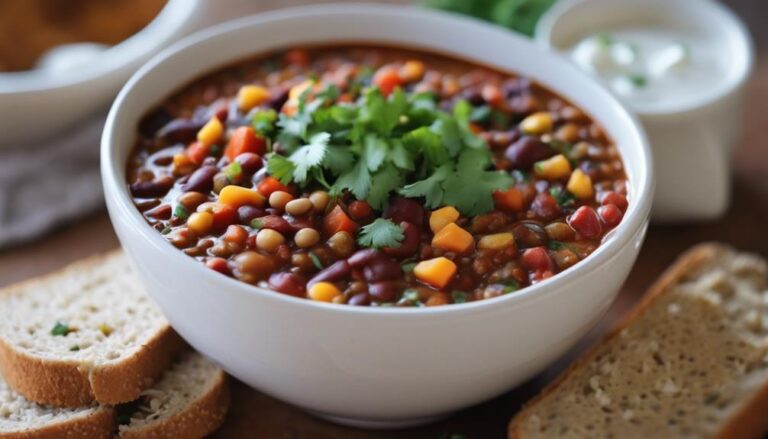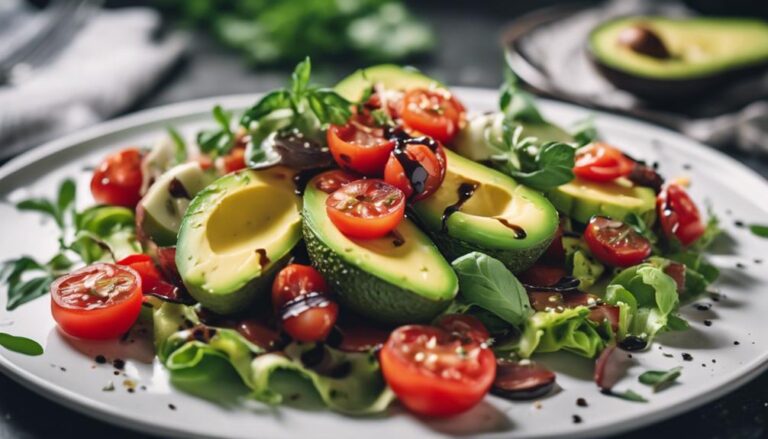Sous Vide Roasted Beet and Quinoa Salad: A Daniel Fast Lunch
Explore the delicious blend of sous vide roasted beets and quinoa in a Daniel Fast lunch salad. Roast beets sous vide for enhanced flavors and prepare quinoa as a hearty base. Mix in leafy greens and top with nuts or cheese for crunch. Dress lightly for added zest. Sous vide keeps flavors rich and vibrant, ensuring a delightful, nutrient-packed meal. Ideal cooking temperatures maintain taste and safety. Enjoy a colorful and satisfying salad that offers both taste and health benefits.
What You Will Learn Here
- Sous vide enhances beet flavors and colors for a vibrant salad.
- Quinoa provides a hearty base rich in essential nutrients.
- Daniel Fast-friendly ingredients promote health and well-being.
- Incorporate leafy greens and crunchy toppings for texture and freshness.
- Create a colorful, visually appealing salad for a satisfying lunch.
Beet's Ancient Culinary Roots

Beets have a long history in culinary traditions, dating back to ancient times. Their rich, earthy flavor and vibrant color have made them a staple ingredient in various cuisines worldwide.
As you explore the roots of beet dishes, you'll discover their evolution alongside other nutritious ingredients like quinoa.
Beet's Historical Significance
With its ancient culinary roots dating back centuries, the beet has played a significant role in various traditional cuisines around the world. In many cultures, beets weren't only valued for their earthy sweetness but also held symbolism. Ancient civilizations cultivated beets for their versatility in cooking and believed in their medicinal properties. Beets were used in various ways, from salads to soups, showcasing their culinary diversity.
The deep red color of beets symbolized love, prosperity, and good fortune in some societies, making them a staple in festive dishes and rituals. The historical significance of beets extends beyond their culinary uses. They were often incorporated into traditional folk remedies and herbal medicine due to their perceived health benefits. Whether roasted, pickled, or boiled, beets have left a lasting mark on culinary history, inspiring creativity in the kitchen and providing a nutritious addition to meals.
Today, the beet continues to be a beloved ingredient in various cuisines, appreciated for its unique flavor profile and cultural significance.
Quinoa's Nutritional Value
When exploring the nutritional value of quinoa, its high protein content and rich array of essential nutrients stand out as key factors in its popularity. Quinoa is a powerhouse grain, packed with benefits for your health. Not only is it a complete protein source, containing all nine essential amino acids, but it's also rich in fiber, vitamins, and minerals like iron and magnesium.
Incorporating quinoa into your meals can be a nutritious choice. Try cooking it in vegetable broth for added flavor or mixing it with colorful vegetables for a vibrant and satisfying dish. Quinoa salads, stir-fries, and even breakfast bowls are popular ways to enjoy this versatile grain.
On the other hand, beets offer a variety of health benefits too. With different beet varieties available, such as red, golden, and Chioggia, you can add a pop of color and nutrients to your dishes. Beets are known for their high levels of antioxidants, vitamins, and minerals like folate and potassium. Roasting, steaming, or pickling beets can enhance their natural sweetness and earthy flavor, making them a delicious addition to salads, soups, and side dishes.
Culinary Evolution of Beets
Delving into the culinary evolution of beets reveals a rich history that spans back to ancient civilizations. Beets, with their vibrant color and earthy flavor, have been used in cooking for centuries. In ancient times, the beetroot was primarily valued for its medicinal properties rather than its culinary appeal. However, over time, people began to explore the culinary benefits of beets, incorporating them into various dishes for their unique taste and nutritional value.
Today, beets are celebrated for their versatility in the kitchen. From salads to smoothies, beets have found their way into a wide range of modern dishes, adding a pop of color and flavor. Apart from their culinary uses, beets boast several health benefits. They're rich in essential nutrients like fiber, vitamins, and minerals. Cooking methods such as roasting, boiling, or even pickling can enhance the beet's natural sweetness and texture while preserving its nutritional value.
Including beets in your diet can be a delicious way to boost your overall health and well-being.
Key Salad Components
Consider the essential elements that make up this flavorful Sous Vide Roasted Beet and Quinoa Salad. When preparing this delightful dish, focus on the following key components:
- Salad Dressings: Enhance the flavors of your salad with a variety of dressings such as balsamic vinaigrette, lemon tahini, or honey mustard. Experiment with different flavor profiles to find the perfect match for your taste buds.
- Quinoa Preparation: Cook the quinoa using methods like boiling, steaming, or using a rice cooker. Guarantee the quinoa is fluffy and well-cooked to provide a hearty base for your salad.
- Roasted Beets: Sous vide cooking method brings out the natural sweetness and earthy flavors of beets. Roast them to perfection for a caramelized taste that complements the quinoa.
- Fresh Greens: Add a pop of color and freshness to your salad with a mix of leafy greens like arugula, spinach, or kale.
- Toppings: Elevate your salad with crunchy toppings such as toasted nuts, seeds, or crumbled feta cheese for added texture and flavor.
Top Sous Vide Beet Recipes

Looking for some excellent Sous Vide beet recipes? Check out these delicious options:
a unique beet and quinoa blend that will tantalize your taste buds
and
a quinoa and beet medley that's both nutritious and flavorful.
These Sous Vide beet recipes are sure to impress your family and friends at your next gathering.
Delicious Sous Vide Beet Recipe
To elevate your culinary experience, explore these top sous vide beet recipes that promise a burst of flavors and invigorating colors on your plate. Sous vide techniques have become a popular culinary trend, offering precise cooking and enhanced flavors.
When preparing beet salad, flavor profiles can be intensified through the sous vide method, resulting in tender and tasty beets.
Here are some delicious sous vide beet recipes for you to try:
- Sous Vide Balsamic Beets: Infuse your beets with the sweet and tangy notes of balsamic vinegar for a delightful flavor combination.
- Honey Garlic Sous Vide Beets: Create a savory-sweet blend by adding honey and garlic to your sous vide beets, perfect for a unique taste experience.
- Citrus Herb Sous Vide Beets: Brighten up your beets with citrus zest and fresh herbs, adding an exhilarating twist to your dish.
- Sous Vide Beet Carpaccio: Thinly sliced sous vide beets layered elegantly on a plate, drizzled with olive oil and sprinkled with sea salt for a simple yet sophisticated appetizer.
- Sous Vide Beet and Goat Cheese Salad: Combine the earthy beets with creamy goat cheese, creating a harmonious balance of flavors in a hearty salad.
Unique Beet and Quinoa Blend
Elevate your culinary repertoire with a fusion of tender sous vide beets and nutrient-rich quinoa in a delightful and unique blend. This flavorful combination brings together the earthy sweetness of beets with the nutty texture of quinoa, creating a dish that's as visually appealing as it's delicious.
The vibrant colors of the beets and quinoa will brighten up any plate, making it a feast for the eyes as well as the taste buds.
- Flavorful Combination: The natural sweetness of beets complements the earthy flavor of quinoa, creating a harmonious blend of tastes.
- Vibrant Colors: The deep red of the beets contrasts beautifully with the light tones of the quinoa, making for an aesthetically pleasing dish.
- Creative Culinary Pairings: Experiment with adding herbs like parsley or cilantro to enhance the flavors and elevate the dish even further.
- Health Benefits: Beets are packed with antioxidants and fiber, while quinoa is a complete protein, making this blend a nutritious choice for any meal.
- Serving Suggestions: Enjoy this unique beet and quinoa blend as a side dish or main course for a wholesome and satisfying meal.
Quinoa and Beet Medley
For a delectable exploration of sous vide beet recipes, consider diving into the flavorful world of Quinoa and Beet Medley. Quinoa, a protein-packed grain, boasts numerous health benefits like being high in fiber and containing all nine essential amino acids. When paired with roasted beets, this medley offers a delightful fusion of flavors and textures.
Here are some ways to enjoy this vibrant combination:
- Quinoa Benefits: Discover the nutritional perks of quinoa, such as aiding weight loss, improving heart health, and boosting energy levels.
- Creative Recipes: Explore innovative ways to incorporate quinoa into your meals, from quinoa salads to quinoa-stuffed peppers, adding a nutritious twist to your dishes.
- Roasted Beet Pairings: Experiment with different roasted beet pairings like goat cheese, walnuts, arugula, and balsamic glaze for a harmonious blend of sweet, earthy, and tangy flavors.
- Flavor Profiles: Explore the diverse flavor profiles of beets, which can range from subtly sweet to rich and earthy, enhancing the overall taste of your quinoa dishes.
- Colorful Presentation: Elevate your plate presentation by combining the vibrant hues of beets and quinoa, creating visually appealing and appetizing meals that are as pleasing to the eye as they're to the palate.
Sous Vide Temperature Recommendations
When it comes to sous vide cooking, temperature control is essential.
Ideal sous vide temps guarantee that your food is cooked to perfection every time.
Precision cooking techniques not only enhance flavors but also secure food safety.
Optimal Sous Vide Temps
Consider setting the sous vide temperature based on the specific ingredients to achieve the best results in your cooking process. For beet cooking, a temperature around 185°F (85°C) is optimal for sous vide. This temperature guarantees that the beets are cooked through while retaining their natural sweetness and vibrant color.
When it comes to quinoa, the benefits of sous vide cooking lie in its ability to perfectly cook the quinoa grains without the risk of becoming mushy or overcooked. Setting the sous vide temperature to 185°F (85°C) is recommended for quinoa as well. This temperature allows the quinoa to absorb flavors from any seasonings or liquids you add to the cooking pouch while maintaining a fluffy texture.
Ensuring Food Safety
To ensure food safety when using sous vide cooking, it's crucial to follow recommended temperature guidelines for different ingredients. Proper food storage and temperature control are essential to prevent the growth of harmful bacteria. Make sure to store ingredients at the appropriate temperatures before and after cooking to maintain their freshness and quality.
When handling ingredients for your sous vide dishes, be mindful of cross-contamination. Keep raw meats separate from ready-to-eat foods like vegetables and fruits. Use different cutting boards and utensils for raw and cooked items to avoid spreading bacteria.
Wash your hands thoroughly after handling raw ingredients, especially meat, to prevent the transfer of harmful pathogens.
Precision Cooking Techniques
For precise cooking techniques in sous vide, it's essential to adhere to specific temperature recommendations for different ingredients. Sous vide benefits from temperature precision, ensuring that your dishes are cooked perfectly every time. This cooking innovation allows for precise control over the cooking process, resulting in consistent and delicious outcomes.
When using sous vide for flavor infusion, it's important to match the temperature to the ingredient. For example, meats like steak require a higher temperature to achieve the desired level of doneness, while delicate vegetables may need a lower temperature to maintain their texture and flavor.
Final Thoughts

In wrapping up your culinary journey with this Sous Vide Roasted Beet and Quinoa Salad, reflect on the essential role each ingredient plays in creating a balanced and wholesome meal that elevates this dish to a delightful experience.
The earthy sweetness of the roasted beets, the nuttiness of the quinoa, and the freshness of the herbs all come together in a symphony of taste that's both satisfying and nourishing.
As you think back on your personal experience preparing and savoring this salad, consider how each component contributed significantly to the overall harmony of flavors.
This dish not only delights the taste buds but also provides a nutritious option that's perfect for sharing with loved ones or serving at gatherings.
The vibrant colors of the beets and herbs make it visually appealing, adding to the overall enjoyment of the dining experience.
Frequently Asked Questions
Can I Substitute Quinoa With Another Grain in the Salad?
Yes, you can substitute quinoa with a variety of grains in the salad. Consider options like brown rice or farro for different textures and flavors. Experiment with different cooking techniques to enhance the dish's nutritional benefits.
How Long Can I Store the Roasted Beets in the Fridge?
To keep your roasted beets fresh in the fridge, store them in an airtight container. Properly refrigerated, roasted beets can last for up to 5 days, maintaining their flavor and texture for you to enjoy!
Are There Any Recommended Dressings for the Salad?
For your salad, consider dressings like balsamic vinaigrette or lemon tahini. These options complement the earthy beets and nutty quinoa. They offer a balance of flavors and enhance the dish's nutritional benefits. Customize with herbs or citrus for variety.
Can I Use a Different Cooking Method for the Beets?
You can try roasting the beets as a different cooking method. It will bring out a rich, caramelized flavor. For quinoa replacement, consider using other grains like brown rice or farro for a satisfying alternative.
Is It Necessary to Peel the Beets Before Sous Vide Cooking?
You should peel the beets before sous vide cooking. The skin can have an earthy flavor that might not be pleasant when eating the salad. Additionally, removing the skin guarantees a smoother texture in your dish.
Conclusion
To sum up, incorporating sous vide roasted beets into a quinoa salad is a delicious and nutritious option for a Daniel Fast lunch. The gentle cooking method of sous vide enhances the flavors of the beets while preserving their nutrients.
By combining these key salad components, you can create a satisfying and healthy meal that's perfect for maintaining a balanced diet during the fast. So why not give this recipe a try and enjoy a flavorful and wholesome meal today?











